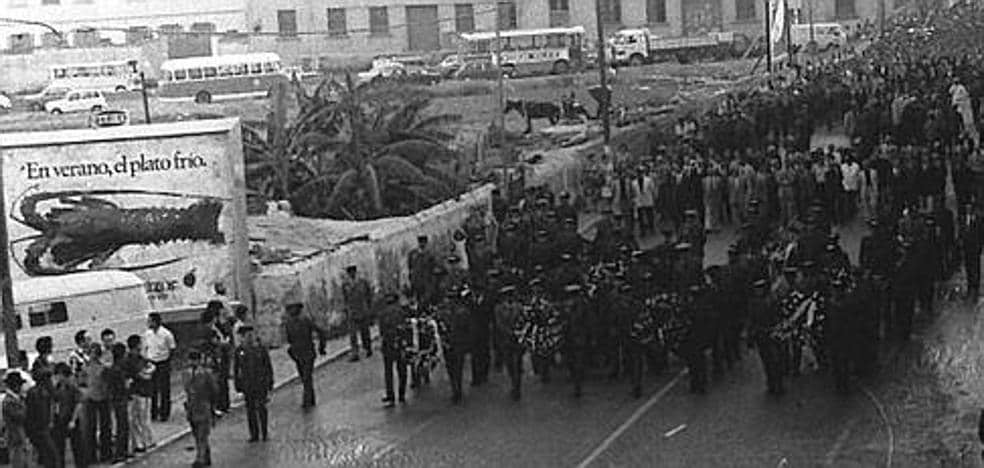Your God and my hell, was the title of the film starring Analía Gadé that could be seen on the Listz cinema billboard the day Franco died. It competed with The Godfather, announced at the Teatro Apolo, and even with the offer of nine theaters more distributed throughout the center and neighborhoods of the capital. The winning number in the local ONCE draw, the famous ‘equals’ that IDEAL published in the day’s issue was 820, popularly known as ‘money’.
Franco’s death had been expected long before his illness was made public and there was no newspaper that had not prepared enough informative material to tell details of his life and what was predicted to happen from that moment on. It goes without saying that queues formed at the newsstands and paper ran out, that official mourning filled the Almeria venues, events were suspended, leisure establishments were closed and the news spread to other venues, with prominence even for new personal. In a few days the news was the oath of King Juan Carlos I and the start of La Transición. For the people of Almería, the week ended with the defeat of AD Almería at home against Jerez (0-2) and with the projection, in the Salón Hesperia, of ‘Silencio de muerte’, an adventure film about Tarzan.
cinema almeria
The year 1975, which had begun in Almería with the national premiere, at the Modern cinema, of the film ‘Una mujer y un cobarde’ directed by Silvio Fernández Balbuena and starring Ágata Lys, who attended the special screening the day after the premiere, It also tried what seemed to be an Alternative Film Festival with continuity, although unfortunately what was born to stay seems to have died in the attempt, with a single edition, that year.
Despite the interest in valuing the importance of cinema in Almería, the idea of the Festival did not come to fruition, among other things because the film industry had started its downward slope when there was a great decrease in co-productions, as well as the fact that the lack of adequate infrastructure, nor were any of the initiatives that had been announced to great fanfare by the administration and that were needed for the development of the industry ever carried out. In addition to this, the worldwide economic crisis of the seventies affected the film sector that substantially lowered production costs.

However, 1975 was not bad in terms of film shooting, accounting for a dozen feature films, highlighting ‘The Reporter’, by Michelangelo Antonioni, with Jack Nicholson and Maria Schneider and ‘The Wind and the Lion’ by John Milius, with Sean Connery. , Candice Bergen. Directors such as Sergio Corbucci, Enzo G. Castellari and Damiano Damiani also filmed that year.
Almeria and ETA
On October 5, 1975, the young 20-year-old civil guard Esteban Maldonado Llorente died in an attack in the Basque Country. Franco was hospitalized and Spain, on the eve of the so-called ‘green march’, abandoned the Sahara and the Sahrawis to their fate. The agent, who had joined his first posting in Mondragón three months earlier, died along with two other colleagues when the terrorists detonated an explosive charge against the vehicle in which the agents were traveling along the road to the Sanctuary of Our Lady of Aranzazu. to Oñate.
Almeria 1975
1974 was coming to an end and, on the site of Doctor Gregorio Marañón street, where two years before the bulldozers began a project described as ‘pharaonic’, a residential and commercial complex was already being built that would be known as ‘CADA’ which, little by little, Little by little, it was filling up with shops, offices and service companies. In the Altamira Shopping Center, as it is called, leading local companies settled in a conglomerate that contained cafeterias and bars, shops, travel agencies, and even a cinema, the Emperor. Years later the ‘Athens Club Disco’ would arrive and a constant flow of business. With this work, the expansion of Almería definitively crossed the Rambla.
More flights than now
You can put yourself however you want, but please take note to learn, from the current president to the last monkey on the staff of the Iberia company, because in 1975 there were not only daily flights with Madrid and Barcelona, but also flights reinforcement three days a week, it was possible to fly to London, with a stopover in Barcelona, three times a week and, except on Sundays, direct flights to Melilla were also offered. Take that! A year earlier, British Airways had already put the Almería-London line into service and the number of charter flights, related to the Almería destination, continued to increase with the seasonality marked by tourism.


